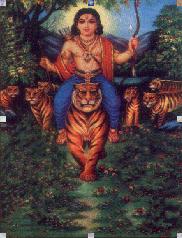Growing popularity of Sabarimala Temple

Pilgrimage to Sabarimala, the forest abode of Lord Ayyappa in Kerala begins during the Mandalam period commencing from the 1st day of the Malayalam month of Vrischikam (November 16). Bearded, black-clad men with their forehead smeared with vibhuti and sandalpaste are seen everywhere giving them a radiant and ascetic look. They are the devotees of Lord Ayyappa who undergo 41 days of penance abstaining from sex, meat and intoxicating drinks. All cities and villages are getting ready for receiving lakhs of pilgrims flooding to Sabarimala, abode of universal brotherhood and equality. The latest estimate of their number is around fifty millions.
The devotees undertake the arduous trekking of 3,000 feet to the forested mountains chanting the prayer “Swamiye Saranam Ayyappa†(Oh Lord Ayyappa, I come to thee for refuge). The pilgrimage inculcates bhakti (devotion), equality of all men and tolerance. It is symbolic of the pilgrimage of the individual self or Jivatma to Paramatma.
The offering to the deity is a ghee-filled coconut which is carried in an Irumudi (two-compartment cloth bag). The pouring of the ghee on the idol marks the consummation of the pilgrimage. Those who observe strict penance and carry Irumudi can step onto the Patinettampadi (18 sacred steps) leading to the sanctum sanctorum. Adolescent girls and young women are prohibited from undertaking the pilgrimage. The river Pampa is the most holy spot besides the Sannidhanam at Sabarimala. A refreshing bath in the Pampa, the great Pampa Feast and the Pampa Vilakku (festival of lights) is a delight to every pilgrim. The Makara Jyoti (luminous light) on the Makara Sankranti day at Kantamala where the Lord shines as the Supreme Brahman in his transcendental abode provides a soothing experience to the pilgrims.
The Sabarimala temple doors are open to all, irrespective of caste, creed, social status or religion. The deity, open to darshan only during specific seasons in the year, attracts millions of devotees all over the world. The pilgrims who go to Sabarimala once are tempted to visit year after year seeking spiritual solace. Those who undertake the maiden pilgrimage has to conduct the ritualistic ceremony known as “Ayyappa Vilakkuâ€.
Lord Ayyappa also known as Dharma Sasta is one of the three Saiva deities, the other two being Ganesa and Muruga. Ayyappa, son of Lord Siva by Mohini, the enchantress is one of the popular deities of the Keralites. Legend and history are intermingled in the genesis of Lord Ayyappa. There is no mention of the name of Lord Ayyappa in any of the recognised Puranas. However, Sasta, a synonym of Ayyappa, is mentioned in a Vedic hymn, as the killer of Jalandhara. In Mahabharata also the name occurs. The name of Ayyappa or Harihara Suta, the son of Hari and Hara, is not found anywhere as a deity admitted in the Puranic pantheon. However, it is quite clear that there is the confluence of Saivism and Vaishnavism in South India. When a blending of the two tenets was felt, Ayyappa came handy. Lord Ayyappa or Ayyanar was born as Hariharasuta, the son of Visnu and Siva.
According to Amarakosa, the Sanskrit dictionary, Sasta is a synonym of Buddha. There are many views in favour of identifying both Buddha and Ayyappa. The Ayyappa devotees always resort to the holy pronouncement of “Ayyappa Saranam” “Swamiye Saranam” and “Saranam Ayyappa”. Some believe that the Ayyappa devotees have adopted the `Saranatraya’ principle of Buddhism. The Ayyappa devotees making a pilgrimage to Sabarimala have similarity with the Buddhist way of ascetic life.
The authentic version of the Ayyappa episode is to based on several folk-songs called Ayyappan Pattu written by village poets in different periods in Malayalam. The Puranic version of the folk song is based on the story of the churning of the Milky Ocean and Lord Vishnu taking the incarnation of Mohini, the enchantress, and Lord Shiva begetting a child from Mohini. These songs put together constitute the “Ayyappa Purana”.Â
There are several stories centred on Sabarimala and Lord Ayyappa both in Puranic and legendary versions where the King of Pandalam, a principality of the erstwhile Travancore plays an important role. The Ayyappa cult is undoubtedly the cream of the Santana Dharma, the eternal religion. The history and evolution of the Ayyappa cult will reveal that it is the most simplified and elegant form of Hinduism made practical and acceptable to all.
(The author is a social activist and Director, Indo-Gulf Consulting. He can be contacted on [email protected])Â
Â
Â
Â
Â
Â
Â
Â
Â
Â
Â
Welcome to Haindava Keralam! Register for Free or Login as a privileged HK member to enjoy auto-approval of your comments and to receive periodic updates.
Latest Articles from Dharma Smriti
- In memory of Dr N Gopalakrishnan
- Treading the Middle-Path on Temple Management
- ആദി ശങ്കര ജയന്തി – പ്രഭാഷണം
- അമേരിക്കന് പ്രൊഫസര് ജോണ് ഗ്രൈംസിന് ഭഗവാന് ഗണേശന് കൊടുത്ത ദിവ്യാനുഭവം
- Forgotten Temples Of Malappuram – Part I (Nalambalam of Ramapuram)
- Holy Karkidakam – Ramayana to Echo from Haindava Homes
- Poonthanam’s complete works translated into English
- Pamba Aarati – Dispell the Engulfing Darkness
- Milords! What the judiciary must know before any final verdict on Sabarimala
- Swami Chidanandapuri on Sabarimala

